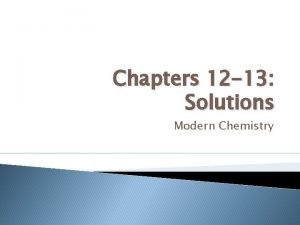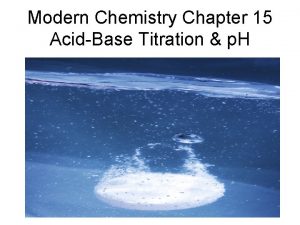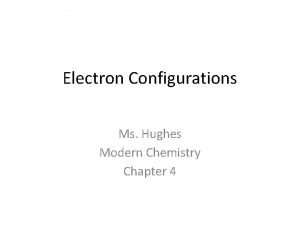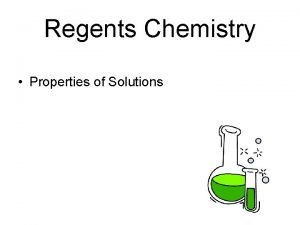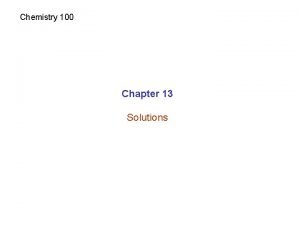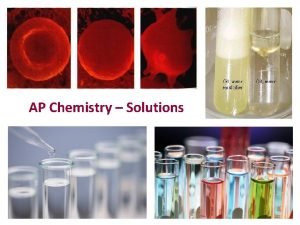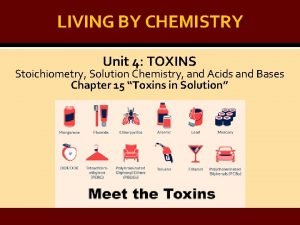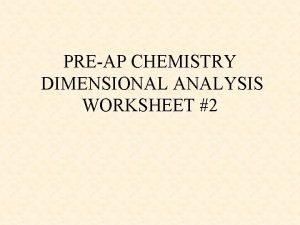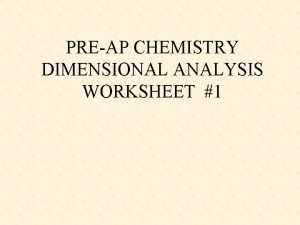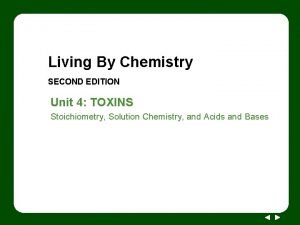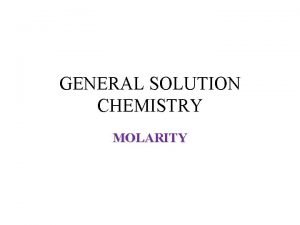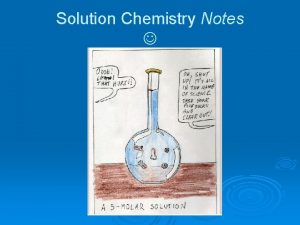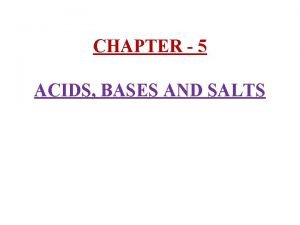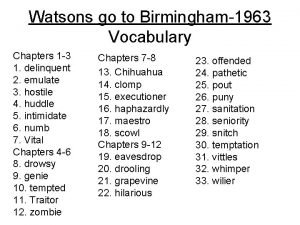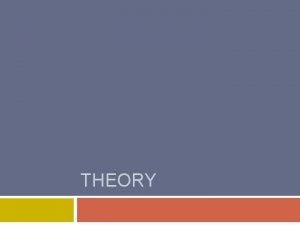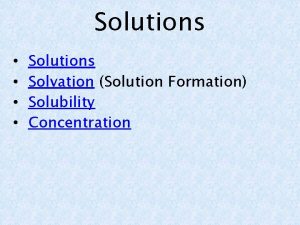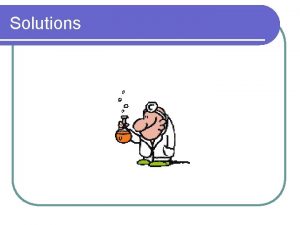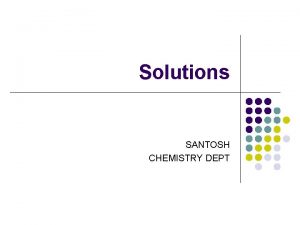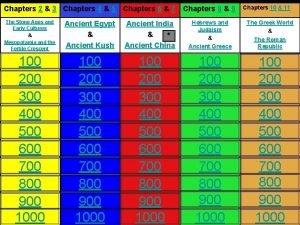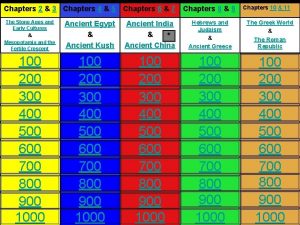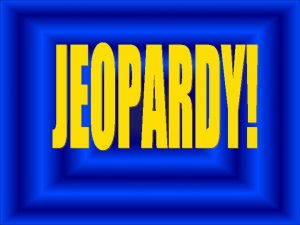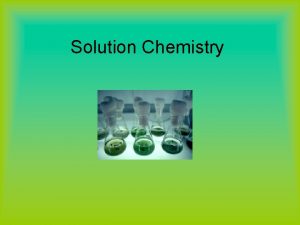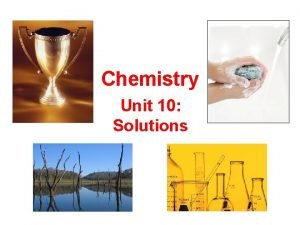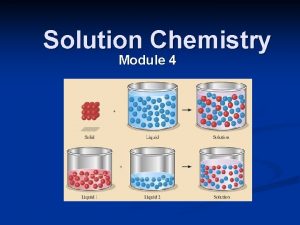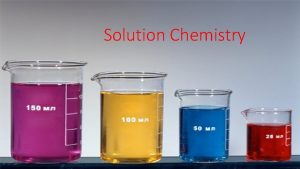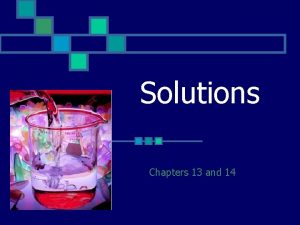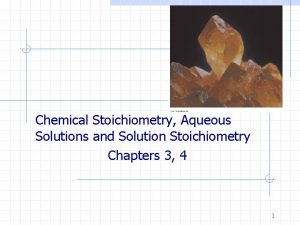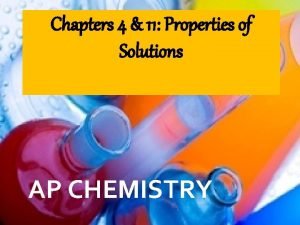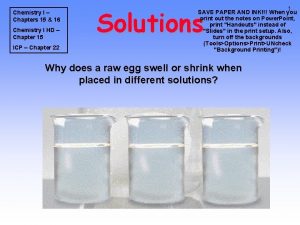Chapters 12 13 Solutions Modern Chemistry Solution Solution












































- Slides: 44

Chapters 12 -13: Solutions Modern Chemistry

Solution � Solution – a homogeneous mixture of a solute and a solvent. � soluble - capable of being dissolved � Solute – the chemical that is dissolved � Solvent – the substance it is dissolved in ◦ Ex. ) Salt in water � Different types depend on state of solute/solvents: ◦ ◦ ◦ Solid-liquid Liquid-liquid Gas-liquid Liquid-gas Solid-solid Gas-gas


�A substance that dissolves in water to give a solution that conducts electric current is called an electrolyte. �Any soluble ionic compound, such as sodium chloride, Na. Cl, is an electrolyte.


Do all compounds dissolve as well as others? � No � Solubility - Maximum amount of solute that can dissolve in a given amount of solvent at a given temperature

Factors affecting solubility 1. “Like dissolves like” ◦ Polar solvents – dissolve ionic/polar solutes ◦ Nonpolar solvents – dissolve nonpolar solutes 2. Pressure ◦ No impact on solid-liquid solutions ◦ For gas-liquid solutions, P Solubility 3. Temperature ◦ Solid-liquid solutions, T Solubility ◦ Gas- liquid solutions, T Solubility

Speed of solution formation Impacted by: 1. surface area 2. agitation 3. temperature

Once a solution forms… Saturated solution – contains the maximum amount of solute Unsaturated solution – contains less than the maximum amount of solute Supersaturated solution – contains more than the maximum amount of solute

Heat of solution � Energy change when a solution forms � Exothermic – releases energy (hot) � Endothermic – absorbs energy (cold)

Solutions calculations � 1. Molarity � 2. Dilutions � 3. Molality

1. Molarity, M Molarity is a standard used to express the concentration of a solution Moles solute M= Liters solution M mol = 1 L

Example: � You have 3. 50 L of solution that contains 90. 0 g of sodium chloride, Na. Cl. What is the molarity of that solution? � You have 0. 8 L of a 0. 5 M HCl solution. How many moles of HCl does this solution contain?

� To produce 40. 0 g of silver chromate, you will need at least 23. 4 g of potassium chromate in solution as a reactant. All you have on hand is 5 L of a 6. 0 M K 2 Cr. O 4 solution. What volume of the solution is needed to give you the 23. 4 g K 2 Cr. O 4 needed for the reaction?

2. Dilutions � The dilution equation is used to accurately make weaker solutions from stronger stock solutions by adding water � M 1 V 1 = M 2 V 2 Stock solution � Weaker solution Initial Molarity x initial volume = final Molarity x final volume

Example � If you have 5 L of a 12 M HCl solution and you want a 3. 5 M solution, how much water should you add? � If you have 2 L of a 8. 5 M HCl solution and you accidentally added 0. 65 L of distilled water, what is the new molarity?

3. Molality, m � Another standard for showing concentration of a solution m moles solute = 1 kg solvent m mol = 1 kg

Examples �A solution was prepared by dissolving 17. 1 g of sucrose (table sugar, C 12 H 22 O 11) in 125 g of water. Find the molal concentration of this solution.

Examples cont. �A solution of iodine, I 2, in carbon tetrachloride, CCl 4, is used when iodine is needed for certain chemical tests. How much iodine must be added to prepare a 0. 480 m solution of iodine in CCl 4 if 100. 0 g of CCl 4 is used?

Chapter 12 Review �Page 426 �#’s 2 -5, 7 -9, 11 -12, 17, 19 -22, 26 -29

CHAPTER 13

Compounds in Aqueous Solutions � Dissociation- into ions Na. Cl(s) Ca. Cl 2(s) Ca 3(PO 4)2 soluble compounds separate Na+(aq) + Cl-(aq)


� How many moles are produced when you dissociate Al 2(SO 4)3 ? � How many moles are produced when you dissolve 1 mole of sodium carbonate?

General Solubility Guidelines

Putting solutions together � Basically, just double replacement reactions � Must determine what precipitates out Cd(NO 3)2 � Use (aq) + (NH 4)2 S (aq) Cd. S(s)+ 2 NH 4 NO 3(aq) Which is the precipitate? the solubility rules to predict

� What precipitate forms when you mix lead nitrate and potassium iodide? � Pb(NO 3)2 (aq) + 2 KI (aq) 2 KNO 3 + Pb. I 2

� Identify the precipitate that forms when aqueous solutions of zinc nitrate and ammonium sulfide are combined. Write the equation for the possible doubledisplacement reaction and include the states of matter.

� Net Ionic Equation – includes only the compounds that undergo a chemical change in the reaction � Spectator ions – do not take part in a chemical reaction � Hint: Watch for a phase change! ◦ Solubility Table pg. 437 ◦ Common ion chart pg. 858

Pb(NO 3)2(aq)+ 2 KI (aq) 2 KNO 3 (aq)+ Pb. I 2(s) Pb 2+(aq) + 2 NO 3 -(aq) + 2 K+(aq)+2 I-(aq) 2 K+(aq) +2 NO 3 -(aq) + Pb. I 2 (s) Spectator ions Called complete ionic equation **To write net ionic equation, eliminate substances that undergo no change** Pb 2+(aq) + 2 I-(aq) Pb. I 2 Net ionic equation (s)

Write complete ionic and net ionic for: 1. Potassium sulfate and barium nitrate 2. Silver nitrate and sodium chloride

Net ionic equation � Strontium nitrate and sodium sulfate

Solution types � Electrolyte – conducts electricity ◦ Strong electrolytes vs. weak electrolytes ◦ HCl vs. HF � Nonelectrolyte – does not conduct electricity

Colligative Properties � Properties that depend on the concentration of solute particles ◦ Vapor Pressure ◦ Freezing Point ◦ Boiling Point

1. Vapor Pressure Lowering � Add solute, vapor pressure goes down (so boiling point goes up) � Non-volatile substance – is one that has little tendency to become a gas under existing conditions

2. Freezing Point Depression � Add solute, freezing point goes down � Kf= freezing point constant = -1. 86℃ � Tf = K f x m � Ex. ) Determine the freezing point of a water solution of fructose, C 6 H 12 O 6, made by dissolving 58. 0 g of fructose in 185 g of water.

� Ex 2. ) Calculate the molality of a solution of 39. 2 g of urea, H 4 N 2 CO, in 485 g of pure acetic acid. Determine the freezing point of this solution.

�A solution consists of 10. 3 g of glucose, C 6 H 12 O 6, dissolved in 250 g of water. What is the freezing point depression of the solution?

3. Boiling Point Elevation � Add solute, boiling point goes up � Kb = molal boiling point constant = 0. 51℃ � Tb = K b x m � Ex. A solution contains 50 g of sucrose, C 12 H 22 O 11, dissolved in 500 g of water. What is the boiling point elevation?

� Ex 2. If the boiling point elevation of an aqueous solution containing a nonvolatile electrolyte is 1. 02℃, what is the molality of the solution?

�A solution contains 450. 0 g of sucrose C 12 H 22 O 11, a nonelectrolyte, dissolved in 250. 0 g of acetic acid. What is the boiling point of the solution?

� In World War II, soldiers in the Sahara Desert needed a supply of antifreeze to protect the radiators of their vehicles. The temperature in the Sahara almost never drops to 0°C, so why was the antifreeze necessary?

Chapter 13 Review Pg. 458 #’s 1 -3, 5, 8, 9, 11, 12, 14, 19, 20, 21, 25, 26, 30

 Modern chemistry solutions
Modern chemistry solutions Analytical chemistry chapter 1
Analytical chemistry chapter 1 Chapter 9 section 3 stoichiometry
Chapter 9 section 3 stoichiometry What is the chemical formula for tetranitrogen heptoxide?
What is the chemical formula for tetranitrogen heptoxide? Modern chemistry chapter 15
Modern chemistry chapter 15 Chapter 14 acids and bases
Chapter 14 acids and bases Modern chemistry chapter 13
Modern chemistry chapter 13 Modern chemistry chapter 12 test
Modern chemistry chapter 12 test Modern chemistry chapter 4
Modern chemistry chapter 4 Ib chemistry organic chemistry
Ib chemistry organic chemistry Inorganic chemistry vs organic chemistry
Inorganic chemistry vs organic chemistry Transaction cannot be subdivided
Transaction cannot be subdivided Regents
Regents Chapter 13 solutions chemistry
Chapter 13 solutions chemistry Ap chemistry solutions
Ap chemistry solutions Living by chemistry solutions
Living by chemistry solutions Dimensional analysis worksheet 2
Dimensional analysis worksheet 2 Dimensional analysis worksheet #1
Dimensional analysis worksheet #1 What is catalystfive
What is catalystfive Chapter 6 chemistry in biology
Chapter 6 chemistry in biology Modern labor economics 12th edition solution
Modern labor economics 12th edition solution Properties of solution in chemistry
Properties of solution in chemistry Difference between mixture and solution
Difference between mixture and solution Solution chemistry definition
Solution chemistry definition Effect of china rose solution on different solutions
Effect of china rose solution on different solutions Immiscible
Immiscible The watsons go to birmingham vocabulary chapters 1-4
The watsons go to birmingham vocabulary chapters 1-4 Tuesdays with morrie study guide answers
Tuesdays with morrie study guide answers Quotes from catcher in the rye
Quotes from catcher in the rye To kill a mockingbird chapter 1 quiz
To kill a mockingbird chapter 1 quiz To kill a mockingbird questions by chapter
To kill a mockingbird questions by chapter Chapter 11 summary to kill a mockingbird
Chapter 11 summary to kill a mockingbird Chapter 4 summary of to kill a mockingbird
Chapter 4 summary of to kill a mockingbird To kill a mockingbird 28-31 summary
To kill a mockingbird 28-31 summary What is chapter 27 about in to kill a mockingbird
What is chapter 27 about in to kill a mockingbird To kill a mockingbird chapter 27-31 summary
To kill a mockingbird chapter 27-31 summary Main events in chapter 7-8 of to kill a mockingbird
Main events in chapter 7-8 of to kill a mockingbird To kill a mockingbird chapter 10-11 summary
To kill a mockingbird chapter 10-11 summary To kill a mockingbird chapter 1-5 quiz
To kill a mockingbird chapter 1-5 quiz To kill a mockingbird chapter 4
To kill a mockingbird chapter 4 Edification definition to kill a mockingbird
Edification definition to kill a mockingbird Things fall apart chapter 4
Things fall apart chapter 4 Chapter 17 summary of things fall apart
Chapter 17 summary of things fall apart Things fall apart chapter 14-16 summary
Things fall apart chapter 14-16 summary Portia nelson autobiography in five short chapters
Portia nelson autobiography in five short chapters
